What are the main things hiring managers to look for when reading a software engineer’s resume? Do you know how to structure your resume in a way that will catch their eye and get you invited to an interview? These are questions that every software engineer must answer when preparing their resume. If you’re looking to break into the tech industry as a software engineer, your resume must stand out from the crowd. After all, there are plenty of job seekers with computer science degrees who can tick the “software engineer” box. But if you have relevant experience, an eye-catching resume is your best chance of getting noticed by companies that are specifically seeking out software engineers. A well-structured resume packed with useful information is essential when applying for any job opportunity. It doesn’t matter if you’re a fresh graduate or an experienced professional, crafting this document will help you achieve your career goals sooner than later.
Software Engineer Resume Example
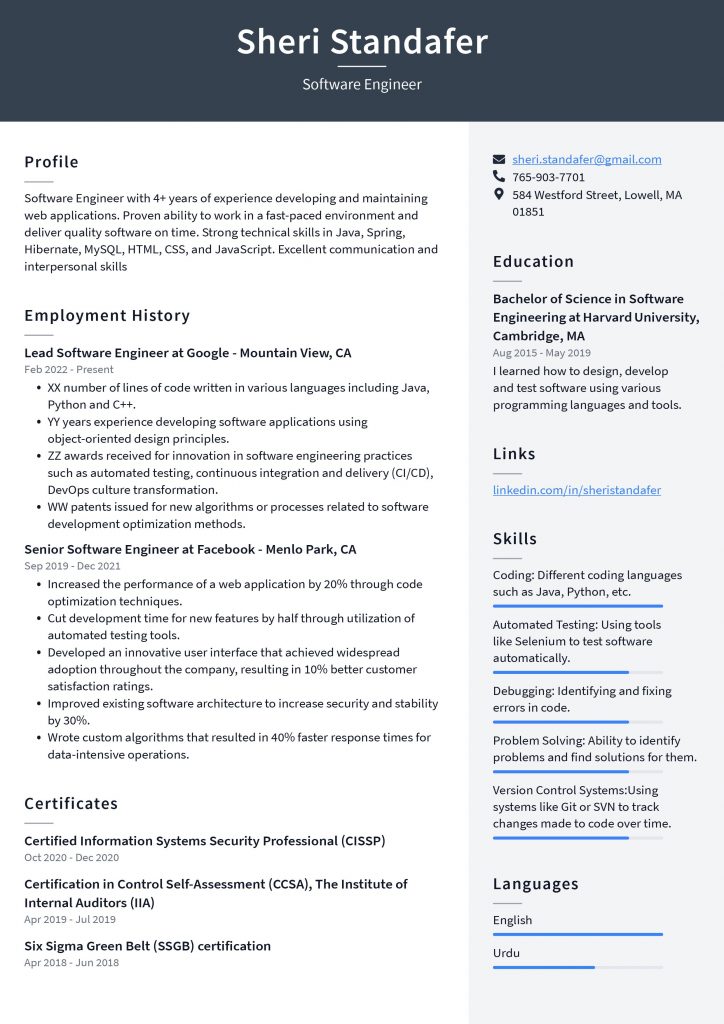
Download This Software Engineer Resume as PDF
Lead Software Engineer Resume Example
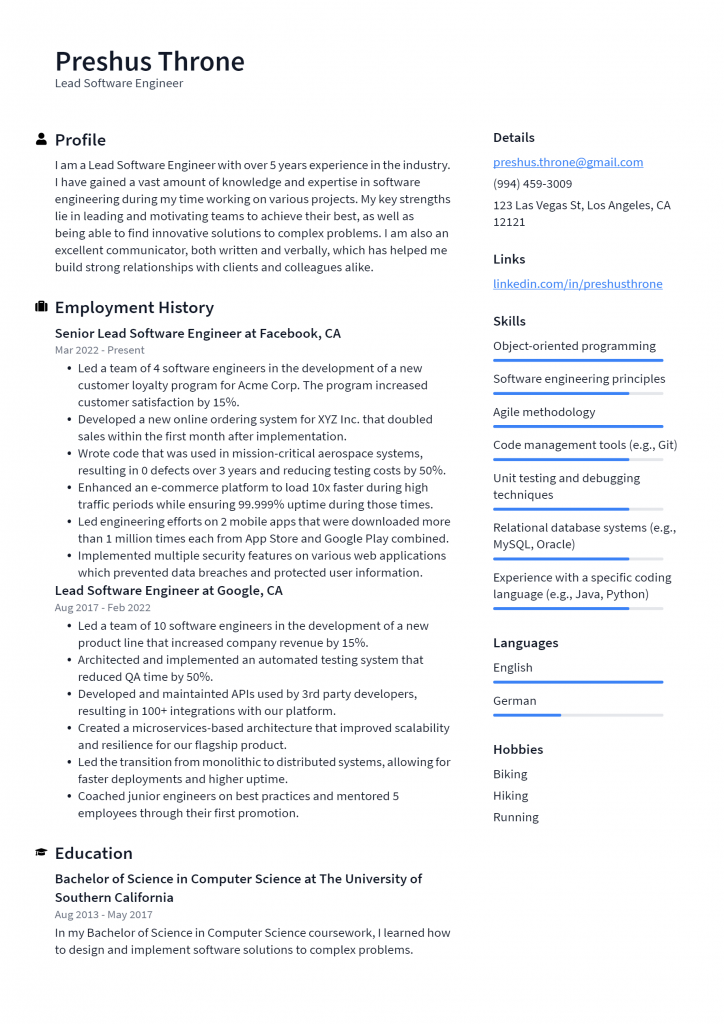
Download This Lead Software Engineer Resume as PDF
Senior Software Engineer Resume Example
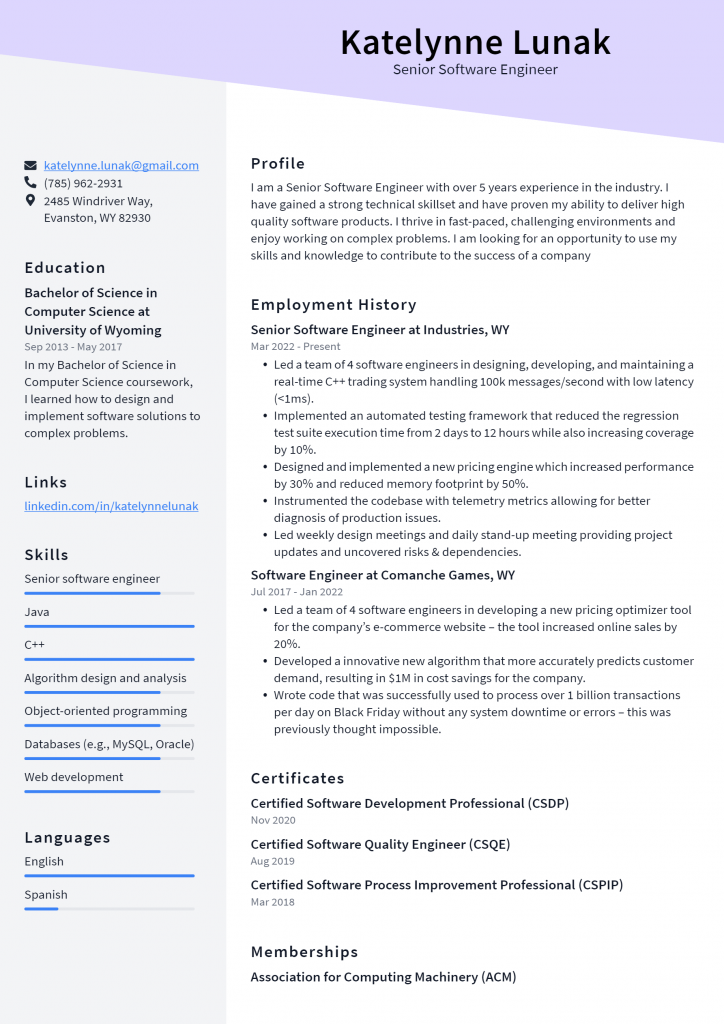
Download This Senior Software Engineer Resume as PDF
Software Engineer II Resume Example
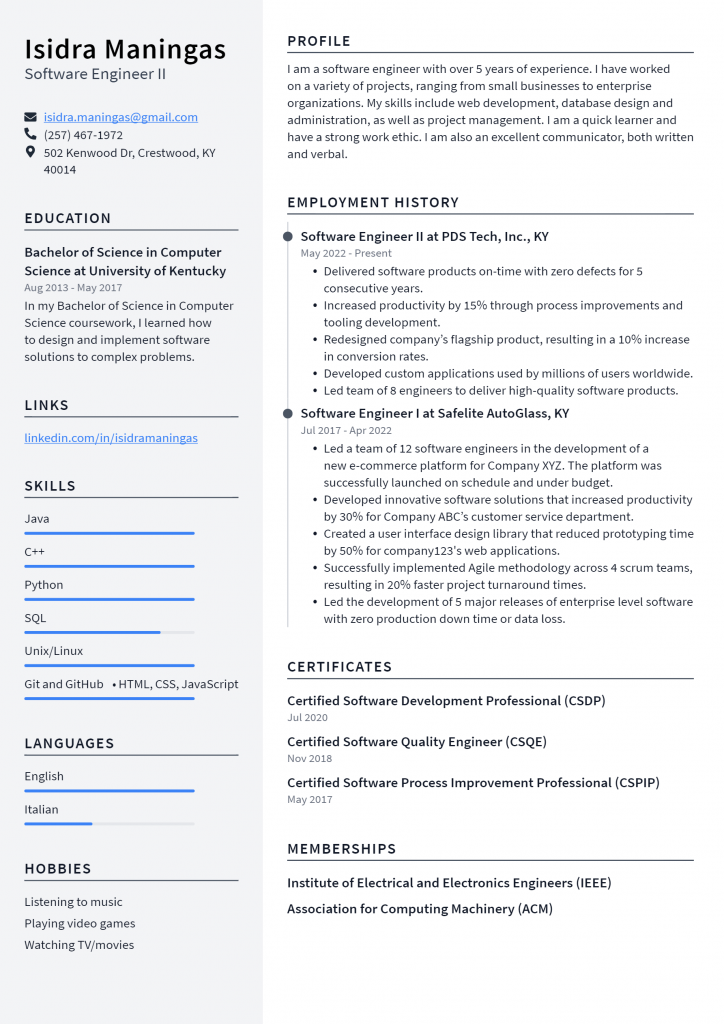
Download This Software Engineer II Resume as PDF
Software Engineer I Resume Example
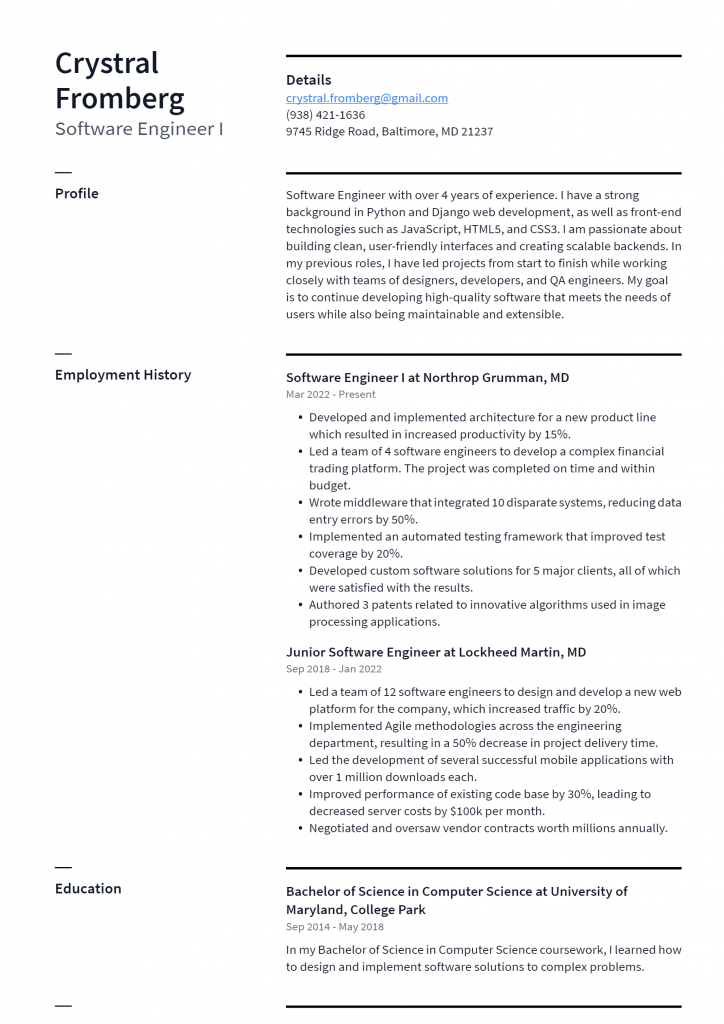
Download This Software Engineer I Resume as PDF
Junior Software Engineer Resume Example
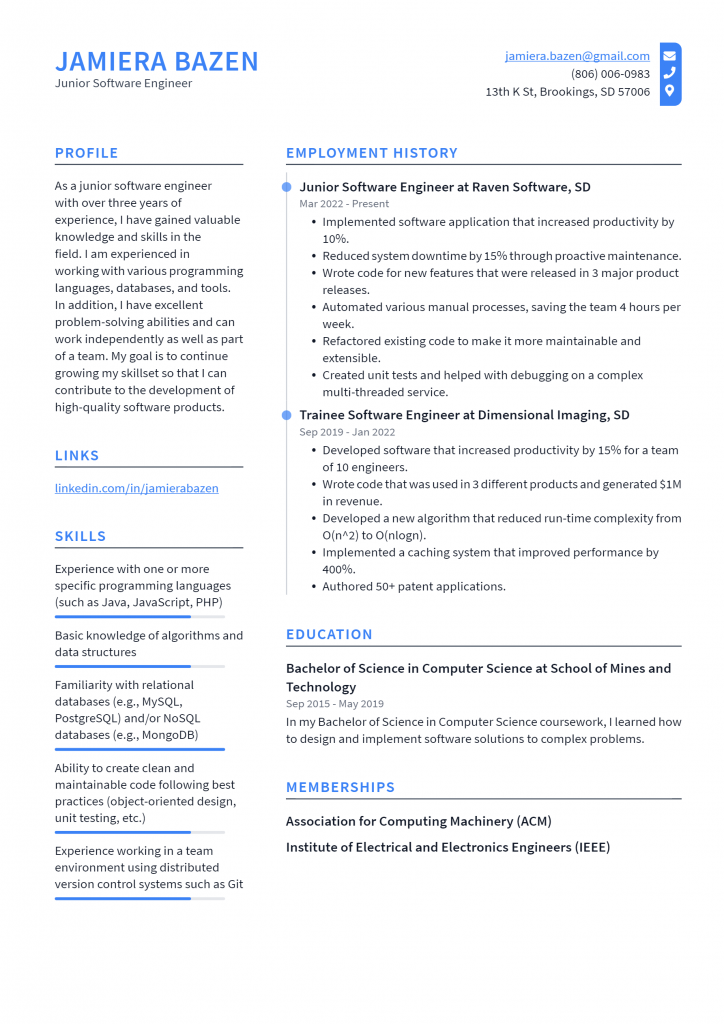
Download This Junior Software Engineer Resume as PDF
Trainee Software Engineer Resume Example
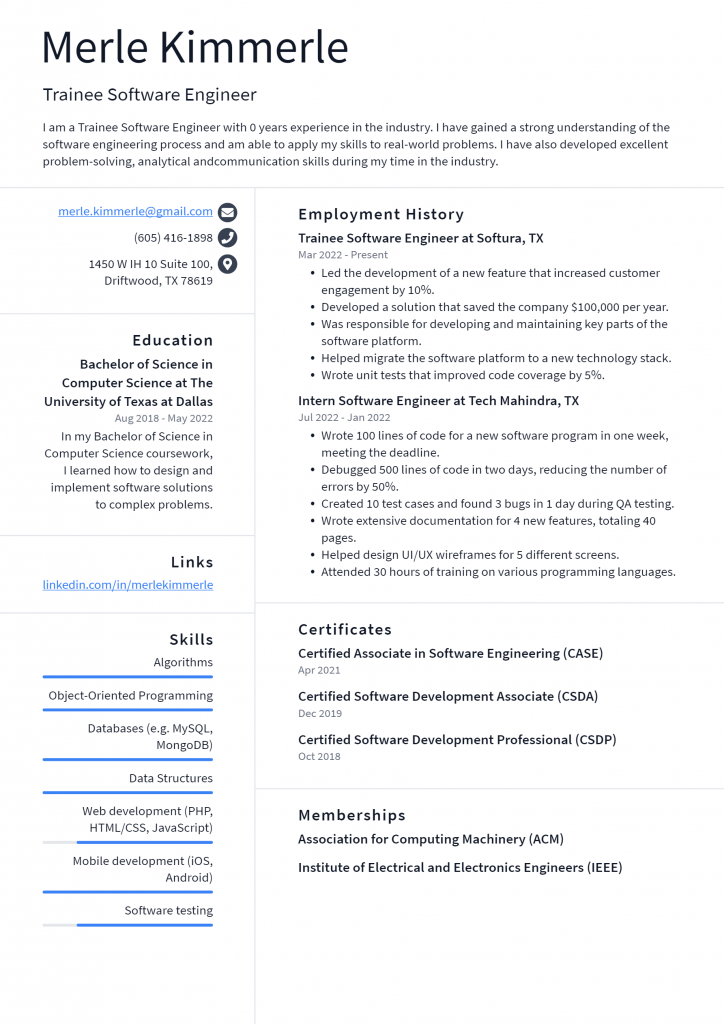
Download This Trainee Software Engineer Resume as PDF
What to Include in a Software Engineer Resume?
A hiring manager will do a quick scan of your resume to determine if you’re worth interviewing. To make this happen, you need to include the following information on your resume: – Summary of qualifications – A summary of the skills you have and the qualifications you hold. – Education and training – The schools you attended and the degrees you earned. The courses you took and any certifications you have. – Professional experience – The roles you held, the companies you worked for, and your achievements. – Languages and tools – All the programming languages and software tools you’re comfortable working with.
Bottom line: Be selective.
The best way to make your resume as relevant as possible is to be selective when choosing which information to include. Make sure that every section in your resume contributes to your overall message and shows the hiring manager why you’re a good fit for the job. Most importantly, your resume should show that you’re the best person for the job you’re applying for. Remember, hiring managers want to see what you can do for the company, not what the company can do for you. So take a critical look at your resume and make sure everything you’ve included is essential and directly related to the job you’re applying for. Doing this will help you avoid including unnecessary information and keep your resume concise. For example, if you’re a software developer and you want to get hired for a marketing role, don’t list your marketing experience on your resume. Instead, focus on the technical skills that are essential for the marketing job, like your proficiency with coding languages and social media management tools.
Summary of qualifications
Your resume should start with a summary of your most relevant skills, qualifications, and experience. It should also include any certifications you have and the industries you worked in. This overview is often the first thing people will see when reading your resume. Therefore, you must choose the right information to put in this section. A hiring manager will quickly scan it to determine if you’re right for the job or not. Make sure to highlight your most transferable skills and the areas of your experience that are most relevant to the job you’re applying for. Keep in mind that you need to put the most relevant information first. This is because hiring managers will often only read the first two or three lines of your resume. Therefore, you want to make sure that your most important skills are displayed at the top of the document.
Education and training
This section should be displayed right after your summary section. It should include the universities you attended and the degrees you earned. It should also include the courses you took, relevant to the job you’re applying for. This is the best place to showcase your knowledge by including course titles, grades, and GPA if that’s relevant. You can also list the skills you acquired from taking those courses and how they would apply to the job you’re applying for. If you have any academic or professional certificates, you should also include them in this section. This includes things like tech certifications, English language proficiency certificates, and any other professional credentials you may hold.
Professional experience
This is where you list the roles you held and the companies you worked for. You should also include any achievements you might have, the projects you worked on, and the impact you had on your companies. The best way to showcase your experience is to include short paragraphs that describe what you did in each role and explain how your actions benefited the company. You should also include relevant information like the industry you worked in, the technologies you used, and the number of people you supervised. If you have any notable achievements, you can include them in a separate section titled “Additional Achievements.”
Languages and tools
This section is where you list all the programming languages and software tools you’re comfortable working with. You can also include any other computer-related skills you have, like proficiency with certain operating systems or software packages. You need to make sure to list the most relevant languages and tools for the job you’re applying for. You want to show the hiring manager that you’re the best candidate for the job. If you don’t know which languages and tools are most relevant for the job you’re applying for, check the job description. You can also ask the hiring manager which languages and tools are most relevant for the job. Once you know which languages and tools are necessary for the job, make sure to include them in this section of your resume.
Conclusion
Your resume must be concise and to the point. You only have a few seconds to catch the hiring manager’s attention and make them want to read more. This means that your resume needs to be organized and easy to read. With that in mind, a resume template can be a great way to start organizing and designing your resume. When it comes to formatting, make sure each section is separated from the others. Use bullet points whenever possible, as they make it easier to skim through the document. And don’t forget to proofread your resume before submitting it. Even the smallest formatting mistake can cost you the job. If you truly want to stand out from the crowd, you need to do more than just include the standard information on a software engineer resume. You need to think outside the box and make a lasting impression on the hiring manager.
Get more help
If you feel like you could use some extra help while writing your resume, there are a variety of free resources available to you. – The first source is your university’s career center. Every university has one, and they’re there to assist all students with their job search. – Next, you can try magazines like Entrepreneur, Forbes, and Inc. These contain advice from top business leaders who can help you with everything from resume writing to networking strategies. – You can also go to online communities and forums where you can ask questions and get advice from other members. – Finally, you can check out online resume examples and templates to get an idea of what a great resume looks like. When you use these resources, you’ll get ideas for what goes into a great resume as well as see examples of what not to do.